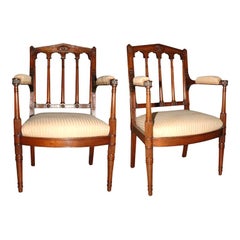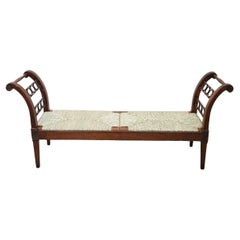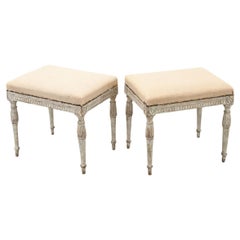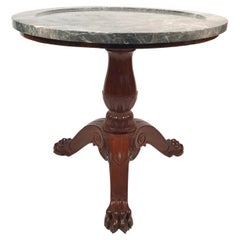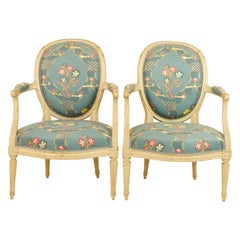Georges Jacob Furniture
Georges Jacob became one of the finest Parisian maîtres ebénistes (master cabinetmakers) of the late 18th and early 19th centuries, despite his humble beginnings and lack of formal training. Renowned throughout Europe for his opulent Louis XVI designs and grand gilt work, Jacob attracted royals, nobiles and other wealthy clientele.
Jacob was born in 1739 to a peasant family in Cheny, Burgundy. At 16, he moved to Paris to become an apprentice to chairmaker Jean-Baptiste Lerouge. While working for Lerouge, Jacob met Louis Delanois, a young menuisier (carpenter) who specialized in seating. Delanois’s distinct Rococo style and neoclassical taste influenced Jacob, whose own talents for design led him to become a maître ebéniste, in 1765.
In 1767, Jacob opened his first furniture-making business, employing several gilders, carvers and joiners to handcraft his designs. His atelier ornately decorated beds, armchairs, benches, screens and center tables with giltwood motifs such as fluting, beading, ribbons and guilloches. Word spread of Jacob’s exceptional furniture among the European elite, capturing the attention of Queen Marie Antoinette, Sweden’s King Gustav III, the United Kingdom’s King George IV and several German princes.
However, in 1789, Jacob lost several of his aristocratic clients at the onset of the French Revolution. Despite his associations with French royalty and nobility, Jacob survived the revolution with the help of his friend, Republican painter Jacques-Louis David.
In 1796, Jacob retired and left his business to his two sons, Georges and François-Honoré-Georges Jacob-Desmalter, also known as Jacob Frères. Under the ownership of his sons, the workshop became a furniture supplier to Emperor Napoleon.
Jacob’s pieces are held in the collections of several international museums and collections, including the Chateau de Chantilly and Chateau de Fontainebleau; the Louvre and the Musée des Arts Décoratifs, in Paris; the Wallace Collection, in London; the Museum of Fine Arts Boston; and the Metropolitan Museum of Art, in New York.
On 1stDibs, find a selection of antique Georges Jacob seating, tables, case pieces and storage cabinets.
Late 18th Century French Directoire Antique Georges Jacob Furniture
Upholstery, Wood
1780s French Louis XVI Antique Georges Jacob Furniture
Upholstery, Wood
Late 18th Century Italian Louis XVI Antique Georges Jacob Furniture
Walnut, Straw
18th Century Swedish Louis XVI Antique Georges Jacob Furniture
Upholstery, Wood, Paint
Early 20th Century French Louis XVI Georges Jacob Furniture
Wood
18th Century French Louis XV Antique Georges Jacob Furniture
Fabric, Oak
19th Century French Louis XVI Antique Georges Jacob Furniture
Walnut
Late 18th Century Italian Antique Georges Jacob Furniture
Pine
19th Century French Louis XVI Antique Georges Jacob Furniture
Fabric, Fruitwood
20th Century French Louis XVI Georges Jacob Furniture
Fabric, Walnut
19th Century French Napoleon III Antique Georges Jacob Furniture
Fabric, Walnut
18th Century Spanish Antique Georges Jacob Furniture
Walnut
18th Century French Louis XVI Antique Georges Jacob Furniture
Upholstery, Wood
19th Century Louis XVI Antique Georges Jacob Furniture
Velvet, Giltwood
Early 1800s French Empire Antique Georges Jacob Furniture
Marble
1770s French Louis XVI Antique Georges Jacob Furniture
Beech, Linen
Early 1800s French Empire Antique Georges Jacob Furniture
Mahogany
1960s Vintage Georges Jacob Furniture
Tin
18th Century French Antique Georges Jacob Furniture
Marble, Bronze
Late 18th Century French Antique Georges Jacob Furniture
Wood
Late 18th Century French Louis XVI Antique Georges Jacob Furniture
Marble, Ormolu
19th Century French Antique Georges Jacob Furniture
Mahogany
18th Century and Earlier French Louis XVI Antique Georges Jacob Furniture
Wood

